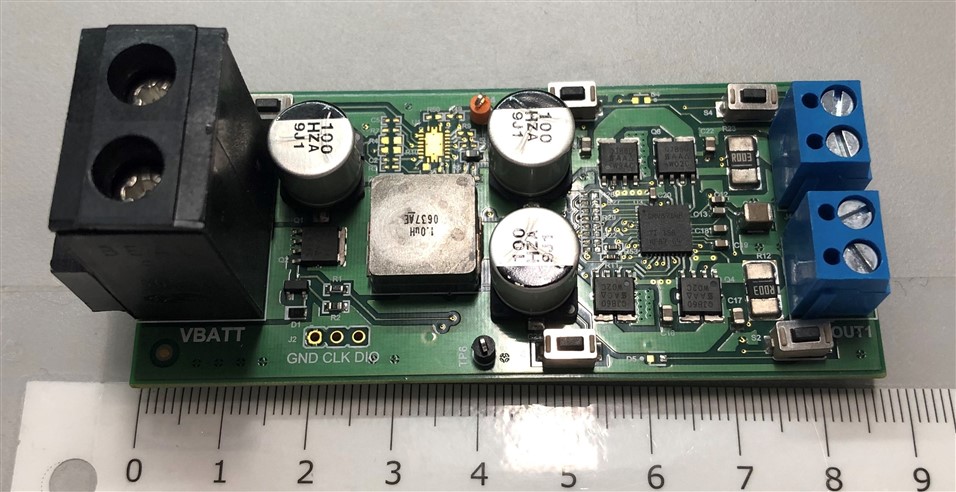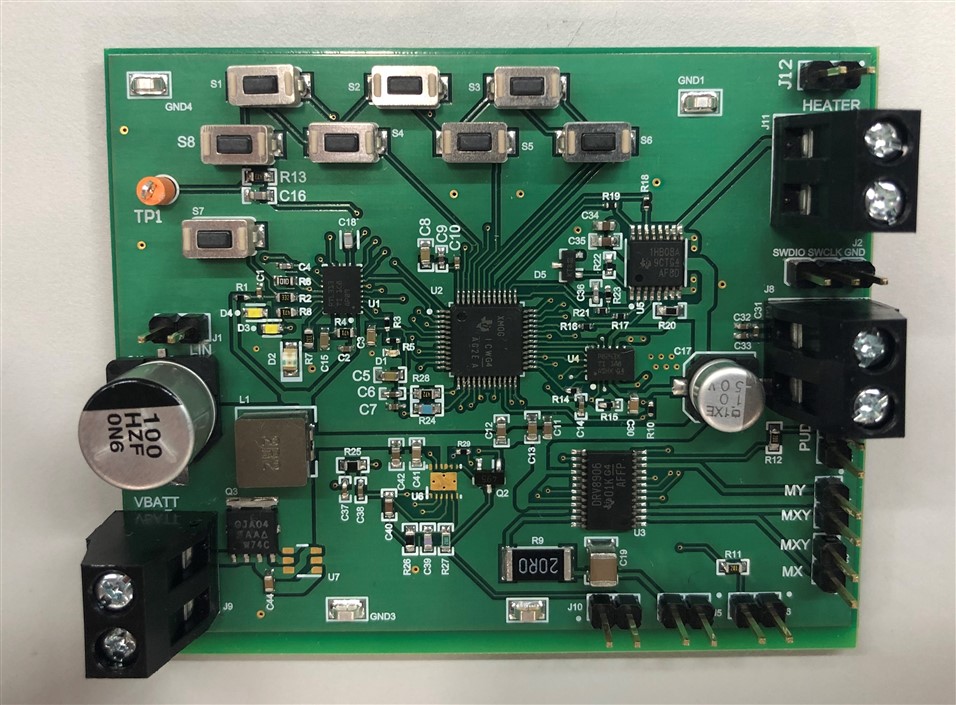Automotive doors are sophisticated systems with many functions beyond simply opening and closing. The electronics for the door functions can be partitioned in several different ways, such as centralized or decentralized modules, or a mix of these two approaches. Every designer will evaluate the selection of modules to best meet the requirements of the specific door design.
With these various architectures in mind, Texas Instruments has made several examples of door modules which can aid designers in their own developments. The following sections introduce these door boards as solutions for different arrangements of door modules. Standard chips optimized for specific functions are combined to provide a flexible solution. Our example designs highlight the range of functions possible with this approach.
A. Dual window module
A dual window drive design provides independent motor drive to two power windows, either front and rear, or left and right. Since the window lift motor current can be high (up to 20 Amps or more), a four half-bridge gate driver, the DRV8714-Q1, allows selection of external MOSFETs with low on-resistance. The DRV8714-Q1 also includes selectable gate drive current for adjusting the voltage slew rate for electromagnetic compatibility (EMC). Two integrated current sense amplifiers provide feedback for torque control, and furnish signals for ripple counting. A TLIN1431-Q1 system-basis chip (SBC) includes a LIN transceiver, low drop-out (LDO) voltage regulator, and a watchdog function. The SBC also includes a high-side switch used for LED illumination of the window control panel. A microcontroller (MCU) controls the window functions and communicates with the rest of the vehicle through the LIN bus.
Figure 1 Dual window drive block diagram

Figure 2 Dual window drive board
B. Base rear door module
The rear door module design includes motor drivers for the rear window and primary door lock, as well as the driver for a secondary or safety lock. All three motor drivers are bi-directional. The window motor drive is independent of the locks, using two half-bridges of the DRV8714-Q1 gate driver plus external FETs. The lock and safety lock drives are coupled, so that each lock can be driven separately, and both locks can be driven simultaneously in the same direction (e.g. both lock or both unlock). This is implemented using the remaining two half-bridges of the DRV8714-Q1 plus the DRV8145-Q1 integrated half-bridge driver. The TLIN1431-Q1 SBC provides LIN communication, a 3.3V voltage regulator, watchdog and high-side outputs for backlight illumination of the control switches. A microcontroller (MCU) controls the window functions and communicates with the rest of the vehicle through the LIN bus.
Figure 3 Base rear door block diagram
Figure 4 Base rear door board
C. Base front door module
The base front door design includes all the functions typical of a front door module. These include the drive for a window lift, primary lock and safety lock, mirror X and Y motion, and the illumination LEDs found in a base-level of vehicle trim. The module communicates with the vehicle network through the CAN bus, under the control of the local microcontroller. Suggested part numbers are found in the block diagram of the figure below.
Figure 5 Base front door block diagram
Figure 6 Base front door board
D. Side mirror module
The side mirror module design fits architectures where the mirror functions are found in a dedicated module in the side mirror assembly. In addition to the X and Y mirror motions and LEDs, a mirror fold feature, defrosting heater, and electrochromic dimming are included.
An LM74700-Q1 ideal diode controller prevents reverse-voltage conditions on the battery line from damaging the circuit. The TLIN1431-Q1 SBC provides LIN communication, a 3.3V voltage regulator, watchdog and high-side outputs for backlight illumination of the control switches. A microcontroller (MCU) controls the mirror functions and communicates with the rest of the vehicle through the LIN bus.
The six-channel DRV8906-Q1 half-bridge driver provides motor drive outputs for the mirror left-right motor and up-down motor. It also controls the three LEDs typically found in the side mirror assembly.
The mirror fold motor is driven by the DRV8245-Q1, with integrated current feedback and diagnostics. A TPS1HB08-Q1 high-side switch controls the heating element for the side mirror. The electrochromic dimming feature is driven by an ALM2402-Q1 power op amp, with PWM input from the MCU.
Figure 7 Side mirror block diagram

Figure 8 Side mirror board
E. Front drives rear with premium mirror module
This design combines the functions of the dual window driver and the side mirror module, and adds CAN communication. The TCAN1162-Q1 combines a high-speed CAN transceiver with FD (flexible datarate), with a 3.3V low-drop-out voltage regulator. The 8-channel DRV8908-Q1 drives the mirror tilt motors as well as several indicator LEDs. The five high-current motors for both windows, locks, and mirror fold are driven by the DRV8718-Q1 gate driver with external FETs, plus a DRV8243-Q1 integrated half-bridge driver. The mirror heater is controlled by a TPS1HB08-Q1 high-side switch.
Figure 9 Front drives rear with premium mirror block diagram
Figure 10 Front drives rear with premium mirror board
F. Luxury door module
The luxury door module combines all the functions of a typical door module plus the more exotic features found in top-of-the-line models, such as armrest heater and door soft-close functions. In addition to the components found in the base front door design, a DRV8245-Q1 integrated full-bridge driver controls the retractable exterior door handle, and a TPS1HB08-Q1 dual high-side switch independently controls the mirror heater and the armrest heater. A ten-channel half-bridge driver, the DRV8910-Q1, drives the mirror tilt motors as well as seven illumination LEDs. The electrochromic mirror tint is driven by the ALM2402 power op amp. This design also includes connection to the LIN vehicle bus as well as the CAN network.
Figure 11 Luxury door block diagram
Figure 12 Luxury door board
In conclusion, there is a trend for adding more features to the automotive door, and these features require electronics to drive, control, and monitor them. Depending on the overall vehicle arrangement, there are different architectures to implement the various modules for the door features and functions. Texas Instruments has a broad portfolio of integrated circuits well suited for the different architectures of door modules, and can support designers with reference designs to speed up development with high confidence. Texas Instruments provides implementation flexibility and excellent performance across a wide variety of door feature requirements.

